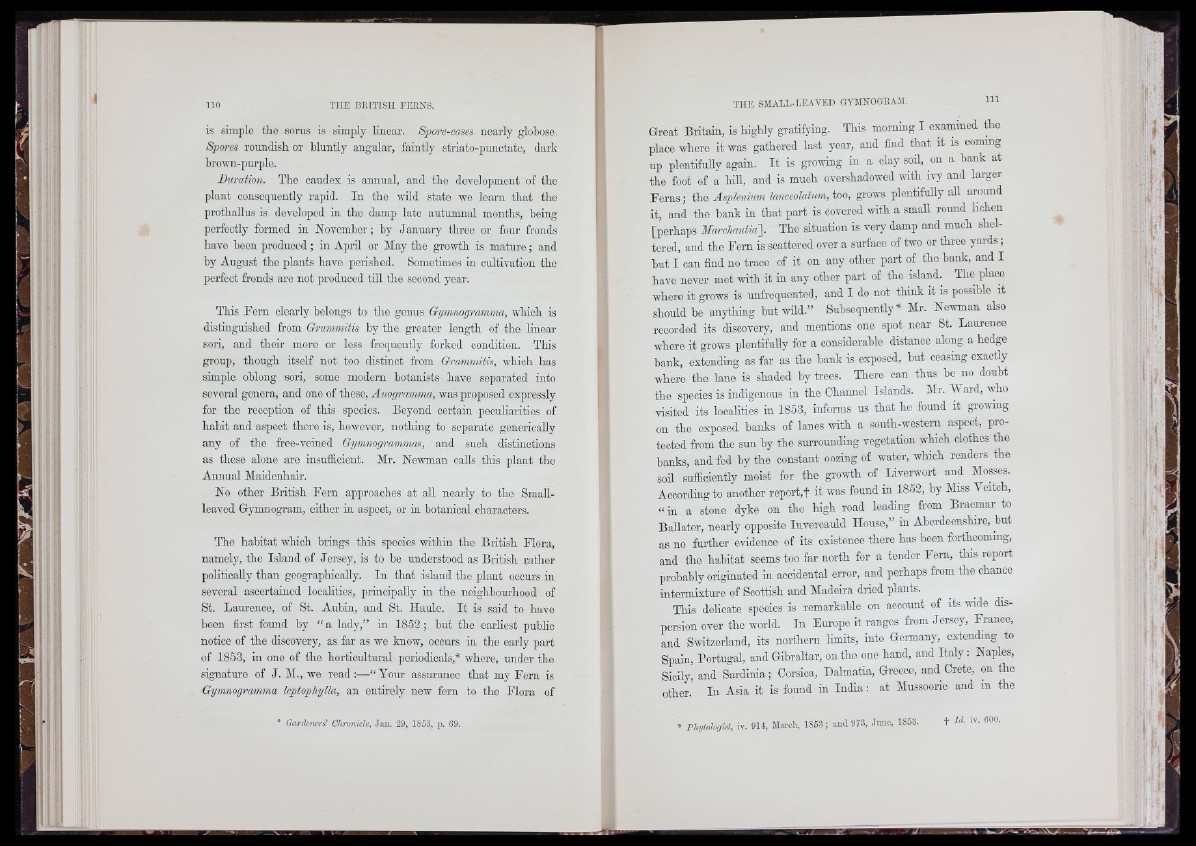
is simple the sorus is simply linoar. Spore-cases noarly globose.
Spores roundish or bluntly angular, faintly striato-punctatc, dark
brown-purplo.
Duration. Tho caudox is annual, and tho development of tho
plant consequently rapid. In tho wild state wo learn th a t the
prothallus is developed in tho damp late autumnal months, being
pci'footly formed in November; by January throe or four fronds
havo been produced; in April or May tho growth is mature; and
by August tho plants havo perished. Somotimos in cultivation the
perfect fronds arc not produced till tho second year.
This Forn clearly belongs to tho genus Gymnogramma, which is
distinguished from Grammitis by tho greater length of the linear
sori, and thoir more or less frequently forked condition. This
group, though itself not too distmot from Grammitis, which has
simple oblong sori, some modern botanists have separated into
several genera, and ono of these, Anogramma, was proposed expressly
for the reception of this species. Boyond certain peculiarities of
hahit and aspect there is, however, nothing to separate genoricaUy
any of the free-voinod Gymnogrammas, and such distinctions
as these alone aro insufficient. Mr. Newman calls this plant tho
Annual Maidenhair.
No other British Forn approaches at all nearly to tho SmaU-
leavcd Gymnogram, either in aspect, or in botanical cbaraoters.
The habitat which brings this species within the British Flora,
namely, the Island of Jersey, is to bo understood as British rather
politically than geographically. In that island tho plant occurs in
several ascertained localities, principally in tho neighbourhood of
St. Laurence, of St. Aubin, and St. Ilaule. I t is said to havo
been first found hy “ a lady,” in 1852; hut the earliest public
notice of the discovery, as far as wo know, ooours in the early part
of 1853, in one of the horticrdtural periodicals,* whore, under the
signature of J. M., wo re ad :—“ Your assurance th a t my Fern is
Gymnogramma leptophylla, an entirely new fern to the Flora of
GardmurS Chronicle, Jan. 29, 1853, p. 69.
Great Britain, is highly gratifying. This morning I examined the
place whore it was gathered last year, and find th a t it is coming
up plentifully again. I t is groiving in a clay soil, on a hank at
tho foot of a hiU, and is much overshadowed ivith 1 1 7 and larger
F o rn s; tho Asplenium lanceolatum, too, grows plentifully all around
it, and the hank in th a t part is covered with a small round lichen
[perhaps Marchantia\ The situation is very damp and much sheltered,
and tho Fem is scattered over a surface of two or three y a rd s;
but I can find no trace of it on any other part of tho bank, and I
have never met wnth it in any other part of the island. The place
whoro it grows is unfrequented, and I do not think it is possible it
should bo anydbing but wild.” Subsequently* Mr. Newman also
recorded its discovery, and mentions one spot near St. Laurence
where it grows plentifuUy for a considerable distance along a hedge
bank, extending as far as the bank is exposed, but ceasing exactly
where the lane is shaded by trees. There can thus be no doubt
tho species is indigenous in the Channel Islands. Mr. Ward, who
visited its localities in 1853, informs ns that he found it grownng
on the exposed hanks of lanes ivith a south-western aspect, protected
from the sun by tho snrrouiidiiig vegetation which clothes the
banks, and fed by the constant oozing of water, which renders the
soil sufficiently moist for the growth of Liverwort and Mosses.
According to another report,! it was found in 1852, by Miss Yeitch,
“ in a stone dyke on the high road leading from Braemar to
Ballater, noarly opposite Iiivercauld House,” m Aberdeenshire, hut
as no further evidouce of its existonoo there has been forthcoming,
and the habitat seems too far north for a tender Fern, tins report
probably originated in accidental error, and perhaps from the chance
intermixture of Scottish and Madeira dried plants.
This delicate species is remarkable on account of its wide dispersion
over the world. In Europe it ranges from Jersey, France,
and Switzerland, its northern limits, into Germany, extending to
Spain, Portugal, and Gibraltar, on the one hand, and I ta ly : Naples,
Sicily, and Sardinia; Corsica, Dalmatia, Greece, and Crete, on the
other. In Asia it is fomid in India : at Mussoorie and in the
’ Phytologist, iv. 914. March, 1853 ; and 973. Jmio, 1858. + Id. iv. 600.